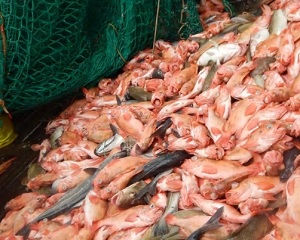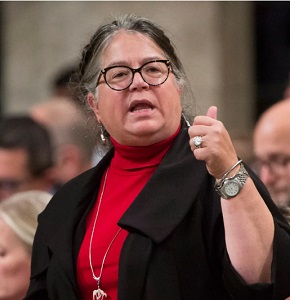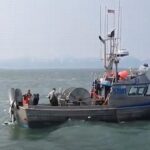 After two seasons of navigating turbulent waters, there is a sense of hope that the Newfoundland and Labrador fishery can finally sail into calmer conditions in April 2024. There was certainly no shortage of conflict on many fronts in 2024, despite efforts to get past some of the tensions that plagued the 2023 season. The provincial government had to step in and help resolve a tie-up by snow crab harvesters in the spring of 2023 that led to a six-week delay to the traditional start of the fishing season. The government formed a committee tasked with finding a better way to settle snow crab pricing, but even its recommendations failed to prevent another disagreement that led to another delayed start in April 2024. more, >>CLICK TO READ<< 09:01
After two seasons of navigating turbulent waters, there is a sense of hope that the Newfoundland and Labrador fishery can finally sail into calmer conditions in April 2024. There was certainly no shortage of conflict on many fronts in 2024, despite efforts to get past some of the tensions that plagued the 2023 season. The provincial government had to step in and help resolve a tie-up by snow crab harvesters in the spring of 2023 that led to a six-week delay to the traditional start of the fishing season. The government formed a committee tasked with finding a better way to settle snow crab pricing, but even its recommendations failed to prevent another disagreement that led to another delayed start in April 2024. more, >>CLICK TO READ<< 09:01
Tag Archives: redfish
NAFO Annual Meeting 2024: Key Decisions on Cod and Redfish Stocks
 A joint proposal from the EU and Canada led to the reopening of the fishery for Northern cod in Divisions 2J, 3K, and 3L, with a revised sharing arrangement. This update was necessary, as the previous provisions had been in place since 1991. The EU’s share was increased to reflect its current composition, ensuring a fairer allocation of fishing rights. Additionally, fishing opportunities for 3M cod were increased, with existing technical measures maintained to protect the stock. NAFO’s decision rewards the fishing sector’s conservation efforts by increasing opportunities while maintaining caution to safeguard stock sustainability. A joint proposal from the EU and Canada led to the reopening of the fishery for Northern cod in Divisions 2J, 3K, and 3L, with a revised sharing arrangement. more, >>CLICK TO READ<< 08:03
A joint proposal from the EU and Canada led to the reopening of the fishery for Northern cod in Divisions 2J, 3K, and 3L, with a revised sharing arrangement. This update was necessary, as the previous provisions had been in place since 1991. The EU’s share was increased to reflect its current composition, ensuring a fairer allocation of fishing rights. Additionally, fishing opportunities for 3M cod were increased, with existing technical measures maintained to protect the stock. NAFO’s decision rewards the fishing sector’s conservation efforts by increasing opportunities while maintaining caution to safeguard stock sustainability. A joint proposal from the EU and Canada led to the reopening of the fishery for Northern cod in Divisions 2J, 3K, and 3L, with a revised sharing arrangement. more, >>CLICK TO READ<< 08:03
Commercial redfish fishery in Gulf of St. Lawrence expected to resume later this month
 The Department of Fisheries and Oceans says the reopening of the redfish fishery in the Gulf of St. Lawrence could begin as early as June 15 and has announced the total allowable catch will be 60,000 tonnes for 2024-25. DFO announced the changes in a statement Friday. The department had said previously that the minimum allowable catch for the fishery would be 25,000 tonnes, but had not provided a cap. The commercial redfish fishery closed in 1995 over stock concerns. more, >>CLICK TO READ<< 13:26
The Department of Fisheries and Oceans says the reopening of the redfish fishery in the Gulf of St. Lawrence could begin as early as June 15 and has announced the total allowable catch will be 60,000 tonnes for 2024-25. DFO announced the changes in a statement Friday. The department had said previously that the minimum allowable catch for the fishery would be 25,000 tonnes, but had not provided a cap. The commercial redfish fishery closed in 1995 over stock concerns. more, >>CLICK TO READ<< 13:26
DFO Doubles Down on Redfish Giveaway: NL MPs Fail to Step-Up for Provincial Fishery
 Late yesterday evening, DFO released the 2024-2025 Management Plan for redfish. The cowardly move came after the close of NL business hours and doubled down by taking owner-operator resources and handing them off to corporations. Earlier this spring, the original announcement made by Minister Lebouthillier gave away nearly 60% of the Canadian redfish quota to the corporate fleet, despite the inshore, owner-operator fleet having taken the lead on science and sustainability measures in recent years. With the Gulf shrimp fishery all but closed and non-shrimpers waiting for redfish to return, this is another blow to a group that’s been in survival mode for the last several years. “Once again, FFAW-Unifor members have been maligned by our two Ministerial Marionettes, Seamus O’Regan and Gudie Hutchings,” said FFAW-Unifor President Greg Pretty. “Sadly, their strings continue to be plucked by the Offshore Groundfish Oligarchy. >>CLICK TO READ<<11:49
Late yesterday evening, DFO released the 2024-2025 Management Plan for redfish. The cowardly move came after the close of NL business hours and doubled down by taking owner-operator resources and handing them off to corporations. Earlier this spring, the original announcement made by Minister Lebouthillier gave away nearly 60% of the Canadian redfish quota to the corporate fleet, despite the inshore, owner-operator fleet having taken the lead on science and sustainability measures in recent years. With the Gulf shrimp fishery all but closed and non-shrimpers waiting for redfish to return, this is another blow to a group that’s been in survival mode for the last several years. “Once again, FFAW-Unifor members have been maligned by our two Ministerial Marionettes, Seamus O’Regan and Gudie Hutchings,” said FFAW-Unifor President Greg Pretty. “Sadly, their strings continue to be plucked by the Offshore Groundfish Oligarchy. >>CLICK TO READ<<11:49
Putting the Cart Before the Redfish
 This was supposed to be a good-news story. In Atlantic Canada’s Gulf of St. Lawrence, redfish have returned from the brink. Nearly 30 years after the fishery was closed, redfish populations have rebounded. Fishers, who have suffered through years of fisheries closures and widespread stock declines, have been eagerly eyeing the reemergence of the resource. But in early 2024, when Canadian fisheries minister Diane Lebouthillier declared that the redfish fishery would reopen later this year, keen observers received the announcement with apprehension. And now, as the reopening draws near—the tentative start date is June 15—conservationists and fishers say that climate change, shifts in the Gulf of St. Lawrence ecosystem, and unfavorable market conditions mean the fishery is unlikely to be the boon many are anticipating. This change of perspective hinges, in part, on research by scientists with Fisheries and Oceans Canada (DFO) that shows redfish have stopped growing. more, >>click to read<< 12:38
This was supposed to be a good-news story. In Atlantic Canada’s Gulf of St. Lawrence, redfish have returned from the brink. Nearly 30 years after the fishery was closed, redfish populations have rebounded. Fishers, who have suffered through years of fisheries closures and widespread stock declines, have been eagerly eyeing the reemergence of the resource. But in early 2024, when Canadian fisheries minister Diane Lebouthillier declared that the redfish fishery would reopen later this year, keen observers received the announcement with apprehension. And now, as the reopening draws near—the tentative start date is June 15—conservationists and fishers say that climate change, shifts in the Gulf of St. Lawrence ecosystem, and unfavorable market conditions mean the fishery is unlikely to be the boon many are anticipating. This change of perspective hinges, in part, on research by scientists with Fisheries and Oceans Canada (DFO) that shows redfish have stopped growing. more, >>click to read<< 12:38
DFO ‘intellectually and morally bankrupt’ in provincial redfish allocations, N.L. minister says
 Corner Brook MHA and former provincial fisheries minister Gerry Byrne says Newfoundland and Labrador deserves a higher allocation of redfish this season and is calling the federal Department of Fisheries and Oceans “intellectually and morally bankrupt” in its decision-making. Nova Scotia received 33 per cent of the quota, Québec 32 per cent, New Brunswick 11 per cent and P.E.I. five per cent. Indigenous fishers and shrimp harvesters will also get an allocation of redfish following a reduction in shrimp quotas. more, >>click to read<< 08:59
Corner Brook MHA and former provincial fisheries minister Gerry Byrne says Newfoundland and Labrador deserves a higher allocation of redfish this season and is calling the federal Department of Fisheries and Oceans “intellectually and morally bankrupt” in its decision-making. Nova Scotia received 33 per cent of the quota, Québec 32 per cent, New Brunswick 11 per cent and P.E.I. five per cent. Indigenous fishers and shrimp harvesters will also get an allocation of redfish following a reduction in shrimp quotas. more, >>click to read<< 08:59
Group for Atlantic offshore redfish fleet says details scarce on fishery reopening
 The organization representing Atlantic Canada’s offshore redfish fleet says it needs more details to better understand the ramifications of Ottawa’s lifting of a decades-long moratorium on the fishery. Fisheries Minister Diane Lebouthillier announced Friday that the moratorium put in place in 1995 would end this year, with an initial overall catch quota of at least 25,000 tonnes for the Gulf of St. Lawrence. Sylvie Lapointe, president of the Atlantic Groundfish Council, says the offshore fleet is facing a steep cut in its share of the fishery after being assigned 59 per cent of the 2024 quota. how the fishery will be managed. more, >>click to read<< 14:12
The organization representing Atlantic Canada’s offshore redfish fleet says it needs more details to better understand the ramifications of Ottawa’s lifting of a decades-long moratorium on the fishery. Fisheries Minister Diane Lebouthillier announced Friday that the moratorium put in place in 1995 would end this year, with an initial overall catch quota of at least 25,000 tonnes for the Gulf of St. Lawrence. Sylvie Lapointe, president of the Atlantic Groundfish Council, says the offshore fleet is facing a steep cut in its share of the fishery after being assigned 59 per cent of the 2024 quota. how the fishery will be managed. more, >>click to read<< 14:12
FISH HARVESTERS UNION CLAIMS HEALTHY COD POPULATIONS
 The Fish, Food and Allied Workers Union (FFAW) has received reports confirming the presence of healthy cod populations near our shores. The union has been advocating for an increase in the total allowable catch for several years, but their efforts have been largely unsuccessful. The Department of Fisheries and Oceans (DFO) takes a cautious approach when determining quotas, despite the fact that the pressure on the cod stock from harvesting activities is minimal. FFAW Secretary Treasurer, Jason Spingle, is urging the Canadian government to conduct a thorough stock survey to obtain more comprehensive scientific data. >click to read< 10:22
The Fish, Food and Allied Workers Union (FFAW) has received reports confirming the presence of healthy cod populations near our shores. The union has been advocating for an increase in the total allowable catch for several years, but their efforts have been largely unsuccessful. The Department of Fisheries and Oceans (DFO) takes a cautious approach when determining quotas, despite the fact that the pressure on the cod stock from harvesting activities is minimal. FFAW Secretary Treasurer, Jason Spingle, is urging the Canadian government to conduct a thorough stock survey to obtain more comprehensive scientific data. >click to read< 10:22

Canada: Positioning for redfish re-opening
Canada’s commercial fishery for redfish in the Gulf of St. Lawrence has remaind closed since 1995 to allow redfish stocks rebuild to healthy levels. Now the authorities are positioning to re-open the Unit 1 redfish commercial fishery in Atlantic Canada and Quebec in the near future. The announcement has been made by Minister of Fisheries Joyce Murray that in preparation for a pending commercial fishery, the 2023 experimental fishery for Unit 1 redfish will be increased from 2500 to 5000 tonnes. Twenty-four individuals and groups from Quebec, New Brunswick, Prince Edward Island, Nova Scotia and Newfoundland and Labrador have been approved to participate, five of which are Indigenous groups. >click to read< 07:48

In Cod’s Shadow, Redfish Rise
In the North Atlantic, the trajectory following fisheries collapse has not been forgiving. Even decades after overfishing drove seemingly inexhaustible species like Atlantic cod off a precipice, many populations—most notably, of Atlantic cod—have remained stubbornly low. But in Canada’s Gulf of St. Lawrence, an exception to the rule is emerging from the depths. Redfish, a deep-dwelling species found in the western Atlantic from Baffin Island to New Jersey, is an unlikely hero: a scarlet groundfish the length of a bulldog sporting a faintly outraged expression and a line of spines sharp enough to draw blood. More to the point: aside from readers of Dr. Seuss, who’s even heard of a redfish? >click to read< 10:10

Nova Scotia looks to keep redfish quota as other provinces want in
A Nova Scotia seafood company is urging the federal government to wait several years before starting a large-scale commercial harvest for redfish in the Gulf of St. Lawrence. Also known as ocean perch, the species has made a remarkable comeback after a 25-year moratorium. “This biomass is huge. It’s probably the largest in history,” said Jan Voutier of Louisbourg Seafoods Ltd., a Nova Scotia redfish harvester and processor. It’s believed 3.5 million tonnes of redfish are in the gulf today, setting the stage for a looming interprovincial conflict in Atlantic Canada over who gets a piece of the action.”All of a sudden, everyone wants to rush in and get the pot of gold, as it were,” said Keith Colwell, Nova Scotia’s fisheries minister. >click to read<12:20
2014 study shows haddock is booming and cod remains in decline in the northeast
 U.S. government scientists reporting on fish stocks off New England are reaching the same conclusions as their Canadian counterparts who have found that haddock is booming and cod remains in decline in the northeast. On Monday, the Northeast Fisheries Science Centre at Woods Hole, Massachusettes released an assessment of 20 northeast ground fish stocks from 2014 surveys. “The rapid increase in haddock, redfish, pollock and white hake contrasts sharply with the decline of cod and the flatfish species,” the report states. Read the rest here 09:13
U.S. government scientists reporting on fish stocks off New England are reaching the same conclusions as their Canadian counterparts who have found that haddock is booming and cod remains in decline in the northeast. On Monday, the Northeast Fisheries Science Centre at Woods Hole, Massachusettes released an assessment of 20 northeast ground fish stocks from 2014 surveys. “The rapid increase in haddock, redfish, pollock and white hake contrasts sharply with the decline of cod and the flatfish species,” the report states. Read the rest here 09:13
Groundfishing aground? The rise and fall of Maine’s offshore fishing industry – Lobster catch keeps going up, up, up
 “I was here from 1989-1996, when we opened up at 4 a.m. and sometimes ran until midnight,” says General Manager Bert Jongerden,,, Now, Portland is a distant third behind New Bedford and Gloucester. The reasons are many, but Jongerden says the Portland Fish Exchange’s fortunes very much have mirrored the rise and fall of New England’s offshore fishing industry over the past 30 years. Read the rest here 11:32
“I was here from 1989-1996, when we opened up at 4 a.m. and sometimes ran until midnight,” says General Manager Bert Jongerden,,, Now, Portland is a distant third behind New Bedford and Gloucester. The reasons are many, but Jongerden says the Portland Fish Exchange’s fortunes very much have mirrored the rise and fall of New England’s offshore fishing industry over the past 30 years. Read the rest here 11:32
NOAA: New Opportunity Proposed for Groundfish Fishermen to Target Redfish
November 7, 2012 — NOAA Fisheries is proposing a new measure to allow members of the groundfish industry to use smaller mesh sizes in their fishing nets in certain areas to target healthy Acadian redfish stocks.


















































